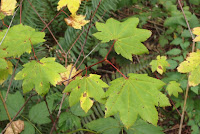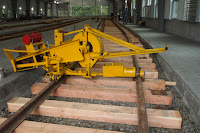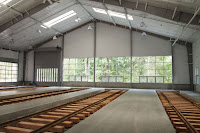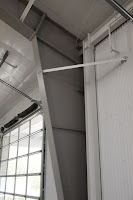The site's railroad ties are made of Douglas-fir. Indoor ties are untreated. The Museum chose copper naphthenate-treated ties for outdoor use. Preferable to waterborne treatments for its low level of leaching, copper naphthenate (unlike creosote) is not listed as a restricted use product by the Environmental Protection Agency.
 The railroad track, built with open graded ballast, is not an impermeable surface. Also, pervious pavers outside the building, and a raingarden to be planted next spring with redflowering currant, cattails and other suitable plants, will enable rainwater to soak into the soil. Stormwater is captured and directed to the raingarden in front of the Train Shed and a detention pond behind the Train Shed so that all water is retained on site except during a major event such as a flood.
The railroad track, built with open graded ballast, is not an impermeable surface. Also, pervious pavers outside the building, and a raingarden to be planted next spring with redflowering currant, cattails and other suitable plants, will enable rainwater to soak into the soil. Stormwater is captured and directed to the raingarden in front of the Train Shed and a detention pond behind the Train Shed so that all water is retained on site except during a major event such as a flood.  The sidewalk alongside the building dips and curves instead of conforming to the original straight, level design in order to avoid removing existing trees. Nevertheless, for every tree cut down, the Museum plants a new tree. Topsoil was harvested from the site and stockpiled prior to construction. The topsoil was then reused after construction was completed.
The sidewalk alongside the building dips and curves instead of conforming to the original straight, level design in order to avoid removing existing trees. Nevertheless, for every tree cut down, the Museum plants a new tree. Topsoil was harvested from the site and stockpiled prior to construction. The topsoil was then reused after construction was completed.  All vegetation being planted on the grounds is native to western Washington. Doug-fir and western redcedar saplings, to be planted at the edge of the surrounding forest, were dedicated during the Train Shed celebration October 2, 2010. Mulch, made from organic material cut from the site during clearing and grading, will help protect against invasives.
All vegetation being planted on the grounds is native to western Washington. Doug-fir and western redcedar saplings, to be planted at the edge of the surrounding forest, were dedicated during the Train Shed celebration October 2, 2010. Mulch, made from organic material cut from the site during clearing and grading, will help protect against invasives.When the Train Shed opens to the public, we hope you’ll enjoy the special features of the building and grounds as well as the historic treasures contained inside.


















